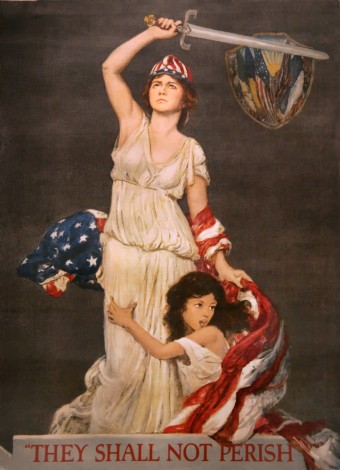How World War I Helped Popularize the Bra
 Corsets dominated the undergarments of wealthier women in the Western world for centuries, until WWI. So how did the war help popularize the bra? In a word, or two words in this case: metal shortage. The making of corsets required quite a bit of metal. Thus, in 1917, the U.S. War Industries Board asked American women to help their “men win the war” by not wearing or buying corsets.
Corsets dominated the undergarments of wealthier women in the Western world for centuries, until WWI. So how did the war help popularize the bra? In a word, or two words in this case: metal shortage. The making of corsets required quite a bit of metal. Thus, in 1917, the U.S. War Industries Board asked American women to help their “men win the war” by not wearing or buying corsets.
This may seem like it would only make a small difference; but, in fact, during the war it is estimated that they freed up around 28,000 tons of steel by this change. (Similar reasoning later led to the banning of pre-sliced bread in the U.S. during WWII, with much less success.)
Besides conserving resources, other aspects of the war also contributed to the demise of the corset and the rise of the bra. For instance, during the war, American women found themselves working in factories, places where it simply wasn’t possible to function properly wearing an ultra-tight, ultra-restrictive corset. Still needing some support in these active jobs, the bra became the most used alternative.
By the end of the war, fashion-conscious women in North America and Europe were now mostly wearing brassieres and soon mass-production of bras ramped up, despite their no longer being metal shortages nor were as many women still working factories and the like. Women in Asia, Africa, and Latin America followed the trend. The reason the switch was more or less made permanent was that corsets were designed to accentuate the curvy Victorian ideal of beauty by cinching the waist and boosting the breasts. In the process, this made it very difficult to breathe and squeezed women’s waists so much that it could even displace organs and cause certain internal problems, along with symptoms such as fainting, gynecological issues, flushing, and nausea, among others. With corsets out, women could move and breathe again.
So who invented the first bra? Wearing a specialized garment to support a woman’s breasts dates as far back as at least the 14th century BC in Greece where women wore a band of wool or linen that was wrapped across the breasts and tied or pinned in the back. Depictions of these first bras can be seen in wall drawing in Crete, worn by female athletes during athletic events. The women in this civilization also seem to have often worn bra-like clothing items that were actually designed to expose the breasts, while also pushing them up and making them more prominent.
As to the modern bra, it isn’t clear who was the first to invent it as numerous patents in various nations were filed in the mid-19th to early 20th centuries concerning bras. Along with the official patent records, an early 19th century push-up bra was recently discovered in the London Science Museum storage rooms; so even before they were being patented, at least some intrepid women seem to have been wearing something like a modern bra design.
The apparent “first” modern bra design patented in the U.S. was made by Caresse Crosby, born Mary Phelps Jacob, who invented her design in 1910. She got the idea for her bra when she was just 19 years old and heading to a ball. Her dress for the evening was a sheer gown. Owing to her large breast size, the dress and a corset didn’t work- the whale bone in the corset stuck out of her dress at the top. She then, with the help of her maid, took two handkerchiefs and some ribbon and sewed them together to make something like a modern day bra, so she would still have support but not need to wear the corset.
After her bra being the talk of the party, with several women requesting she make bras for them, she decided to make a business out of it and patented her “backless brassiere”, with the patent being approved on November 3, 1914. She initially didn’t have much luck selling her bra and decided to close down the business, selling the patent rights to Warners Brothers Corset Company of Connecticut. From the sale she profited $1,500, which is approximately $30,000 today. Not bad, until you consider that Warners Brothers Co. managed to do quite a bit better with the patent, ultimately earning an estimated $15 million, $200-$300 million today, from it in the following three decades.
Various advancements were made on these early bras, reflecting the shifting fashion trends. In the 1920s, the flat chested, flapper look was queen, and bra styles reflected this. Soon a full chested look, not unlike what was produced by corsets, became popular again. In 1947, Frederick Mellinger, founder of Frederick’s of Hollywood, introduced his design for the padded bra; a year later, his design for the modern push up bra came out which was called “Rising Star”. Before 1950, Mellinger would also introduce us to the front hook bra and more colorful brassieres.
In 1977, Lisa Lindahl and her childhood friend, Polly Smith, fashioned the modern day sports bra out of two jock straps (seriously). They teamed up with clothing designer Hinda Miller and soon the “Jogbra” was available to the general public. That same year Victoria’s Secret was founded by Stanford MBA, Roy Raymond.
How we size bras wasn’t invented until the late 1920s or 1930s, with some contention over who actually invented the modern sizing system. Some historians credit William Rosenthal and his wife Ida. Others claim it was S.H. Camp and Company who introduced the A, B, C, D letter sizing, with documented evidence of Camp and Co.’s claim appearing in early 1930s ad campaigns showing such sizing. Whoever was really first, the brassiere sizing system, at least as far as the terminology went, soon caught on with other bra manufactures. Before this, bras tended to come in a mostly one size fits all variety, using stretchable material in the cup to accommodate women of varying sizes.
The sizing method that was come up with, which by the way is not standard from nation to nation, and can even vary somewhat from manufacturer to manufacturer, consists of two measurements – a linear measurement measuring underneath the breasts and around the ribcage, and then a second measurement, measuring the bra cup size itself, which is measured in volume. In this system, an A cup generally can hold around 8 fluid ounces; a B cup around 13 fluid ounces; a C cup around 21 fluid ounces; and a D cup around 27 fluid ounces.
If you liked this article, you might also enjoy our new popular podcast, The BrainFood Show (iTunes, Spotify, Google Play Music, Feed), as well as:
- Marilyn Monroe was Nowhere Close to a Size 12-16
- The First, “First Lady”
- Why Women are Called “Sluts”, “Broads”, “Dames”, and “Chicks”
- The First Woman to Cast a Vote in Chicago Did So With Her Feet
- What Started WWI
Bonus Bra Facts:
- Not surprisingly, considering the slight variance in sizing from bra maker to bra maker and country to country, as well as the fact that weight fluctuation in a woman, even as little as 5-10 pounds, effect bra size, the general consensus is that the vast majority of women out there wear the incorrect bra size. Because of this, it’s often recommended that every single time you go bra shopping, you get re-measured and have a sizing expert make sure a given bra actually is fitting you correctly.
-
The world’s biggest breast augmentation is 38KKK. Those mammoth mammaries are sported by Sheyla Hershey, originally from Brazil, taking her 10 different surgeries to get up to that size. Sheyla’s goal is to some day get her boobs up to 38MMM. I guess she took the sage advice to always dream big literally… While her reasoning behind the surgeries may be essentially vanity (wanting to hold and keep the world record), Sheyla claims her 38KKK breasts once saved her life during a car accident where she wasn’t wearing her seatbelt. Her implants functioned something like an air bag, keeping her from smashing her head on the dash or windshield. Lucky for her, considering the volume of fluids in them, during the accident, her implants did no burst. One also wonders if the reason she wasn’t wearing a seatbelt in the first place had something to do with her breasts. Thus, had she kept her originals, perhaps she’d be a seat belt wearer and she then can’t necessarily claim her buxom bosoms helped out in this situation.
- In 2000, Gisele Bundchen modeled the most expensive bra in history, valued at $15 million. This bra is made from red satin and hand-cut Thai rubies and diamonds. This particular bra holds two Guinness Book of World Records titles as the most extravagant and expensive item of underwear ever created.
- There is an urban legend that the brassiere was invented by a man named Otto Titzling (“tit sling”). There is absolutely no truth to this. The myth was started in the 1971 book The Uplifting Tale of Otto Titzling and the Development of the Bra.
- The word “brassiere” comes from the French “brassière”, meaning “shoulder strap”, ultimately from the Latin “brachhium” meaning “arm”. This wasn’t used to describe bras until the early 20th century, with it appearing in the Oxford English Dictionary in 1911.
| Share the Knowledge! |
|






The authors assertion that “an A cup generally can hold around 8 fluid ounces; a B cup around 13 fluid ounces; a C cup around 21 fluid ounces; and a D cup around 27 fluid ounces” is completely wrong. Cup size changes with bra size. A 40B bra has the same size cup as a 38C, a 36D, a 34DD or a 32E. This means that you cannot say what the breast volume is for a particular cup size.
-Bra Fitting Expert
@ZaftigWendy: As stated, while the fluid ounces listed are supposed to be the standard, this actually varies wildly from manufacturer to manufacturer and country to country and in recent decades this problem of non-standardization has gotten amazingly out of control. The point above was just that the fluid ounces listed were supposed to be the original standard, and some do still hold to these. But, as you say, torso measurements do affect things with, for instance, in practice a 32C, a 34B, and a 36A all sharing the same cup size, differing only in the under band circumference. This, of course as stated in the Bonus Facts, is why most women don’t wear the correct bra size and need bra fitting experts like you to size them for a particular bra.
“..The women in this civilization also seem to have often worn bra-like clothing items that were actually designed to expose the breasts, while also pushing them up and making them more prominent. ” —i demand proof Sir!…umm along with some pictures…post haste!
@Syed Moin Doja: For SCIENCE! 😉
Try this: https://en.wikipedia.org/wiki/Minoan_snake_goddess_figurines
Might you add Howard Hughe and the underwire
push up bra, story ?